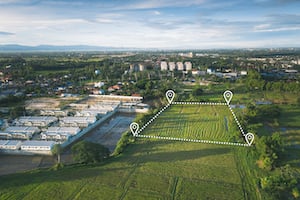6 Real Estate Investing Exit Strategies Every Landowner Should Consider
I’ve talked to hundreds of landowners over my real estate development career. Listening to their stories and how they came about their properties is fascinating.
Sometimes land is passed down and owned in their family for multiple generations. That's usually accompanied by a series of stories, a photo album, and lots of reminiscing. Other landowners have a less emotional attachment to their property – maybe they bought the land to build their forever home and never quite got around to it.
Others stumbled upon some land and bought it as an investment property because the opportunity was too good to pass up.
The point is that there are various reasons someone may own a piece of land. And maybe whatever the original intention was for property, if they had a vision for it, it never came to fruition.
There’s an important lesson in that. Any successful real estate investor or owner will tell you that before buying a property, you need multiple potential exit strategies. For example, what happens if the market turns, the land isn't quite what you originally envisioned, or life circumstances change? And land being an illiquid asset makes it difficult to pivot quickly, so it's critical to contemplate and prepare several contingencies early in a project.
In this article, we will discuss 6 potential exit strategies unique to land that every landowner should be familiar with. We also have a landowners page packed with great resources to help you make more profitable decisions.
But first, if you’ve missed either of the first two articles in our landowner series, you can check them out here – "When is the right time to sell your land as a landowner" and "3 tips for maximizing land value when it's time to sell." These articles offer some helpful context as we dive into a discussion of land exit strategies.
1. Selling a property "as-is"
Selling a property “as-is” is the easiest and quickest path to cashing out on your land. You’ll find a buyer, any investigative work will be their responsibility, and you’ll receive a check for your property at the end of the transaction.
The burden of due diligence rests with the buyer, and as a landowner, it’s a cost-effective way to sell a property. Because instead of investing your own money into the required investigative work, you can instead just discount the purchase price and reduce your risk in selling the land.
It can be hard to predict the intentions of a potential buyer - maybe they think they can flip it, or they want a new location for their business or they’re interested in the land as an estate lot. But that isn’t your problem, and selling the land “as-is” means all of that work will be left to the buyer to investigate.
2. Light feasibility work
A lot of investigative work is required to determine if a piece of land is valuable or even developable. And this spooks many landowners – the sheer volume of real estate due diligence tasks and cash required is a risk they're unwilling to take. It's often just easier to sell a property "as-is" – buyer beware. But as an owner, you're leaving money on the table.
As a real estate developer or land buyer, at minimum, a property's "unknowns" will cost money to investigate, but at worst present potential deal breakers. For instance, if you’re considering a residential development, you may want to know things like:
- Are soils suitable for septic systems?
- How many buildable lots can I get on the property?
- Are there streams at wetlands on the land?
- What is the legal or surveyed property?
Any due diligence material an owner can provide to a buyer offers valuable insight into what the land can support. And because there is significant value in being handed a property with some completed investigative work, any money an owner invests in feasibility work is typically paid back many times over at the property sale.
The challenge lies in knowing what feasibility items may be important to a builder or developer. It's critical to sequence real estate due diligence tasks appropriately, and only complete assessments that may be universally required across various end uses and buyers.
3. Partner with a developer as a limited partner (LP)
In real estate development, substantial barriers to entry exist. Projects are time-consuming and expensive, a lot of expertise is required, and it's challenging to execute a deal with various moving parts.
But despite these fundamental challenges, sourcing quality land opportunities at an affordable price is still probably the biggest bottleneck for developers being able to take on more deals.
This presents an opportunity for landowners.
Instead of simply selling your property to a developer, you could instead structure a joint venture offering you a stake in the project as a limited partner. As a result, you would have no development project responsibilities but enjoy ownership of the deal, potential tax benefits, and an appreciation upside.
There are a couple of different ways to partner with a developer. Still, often the landowner will be included in the deal at the value the real estate developer would have paid for the property. In other words, the landowner’s capital contribution to the project is the land.
A consequence of this strategy is that the deal cycle with a developer is longer than just selling the property. This is because your capital as a landowner will be tied up in the project until the developer either refinances or sells the project.
So, if your goal is to quickly cash out on a project, a real estate joint venture or partnership isn’t the optimal exit strategy. But if you intend to remain in the project for several years, with the potential to capture investment returns, this strategy is worth considering.
However, a joint venture could get messy for a property owner if the developer can't perform on the project. Therefore, it's essential to consider the qualifications of the real estate developer before engaging in a partnership.
4. Fully entitle residential "paper lots" or convert the property to the highest & best use
Land value is derived from the potential future income that can be generated from the property. So before purchasing land, a real estate developer needs to understand what the property can yield and back out development costs to determine a purchase price.
But real estate developers are subject to risk in the permitting and land entitlement process. For example, municipalities can derail or alter projects, and critical operating assumptions to value the land initially may be incorrect.
The approval process usually is time-consuming as well – a developer will have to hire various outside consultants to assist with the process. And that doesn’t guarantee project approval either.
So, to minimize risk, many homebuilders and real estate developers avoid the entitlement process altogether. They'll instead purchase a property with an already approved project and fall in on the existing plan.
Landowners can take advantage of this by converting the property to a higher and better use themselves, then selling the property to a buyer. The property owner will shoulder the land entitlement risks but capture the upside in the increased property value.
This exit strategy requires both time and money to pursue. It also helps to have an understanding of land development and the current state of the market. There won't be inbound cash flows from the property to pay outside consultants during entitlement, which may challenge illiquid owners.
But if you can fully entitle a property, you'll significantly increase the value of the land before selling it to a homebuilder or real estate developer.
5. Land lease - either agricultural or to a developer for a commercial project
A land lease, also known as a ground lease, is a situation where a landowner rents out the land to a tenant.
This arrangement is common in rural areas with lots of available agricultural land – landowners will lease their property to farmers for crop cultivation and livestock.
A land lease is also common in commercial real estate – landowners will lease their property to a real estate developer to develop the property. Commercial ground leases often involve properties in "A+" locations that are difficult to replicate.
As a property owner, a land lease offers a stable income stream and ownership retention of the property. Lease terms are generally anywhere from 50-99 years in length and provide the potential of periodic rent escalations as time goes on.
The primary benefit of a land lease for real estate developers is that they can develop a property without having a significant upfront capital expense associated with the land purchase. This also expands the pool of potential suiters for the property and gives a landowner more options.
But keep in mind not all land leases are structured the same. A significant consideration is how the owner positions themselves in the claim hierarchy – ground leases may be either subordinated or unsubordinated. Depending on how the lease is structured, the property owner may not have the first claim to proceeds if the developer defaults on a construction loan.
A land lease isn't appropriate in every situation and isn't a true land exit, but it offers landowners an alternative income stream in addition to ownership retention.
6. Full development cycle
The most involved and risky land exit strategy is taking a property through the complete development cycle. Not only would the owner be responsible for land entitlement and permitting, but they'd also be on the hook for the ground-up development and property lease-up.
The real estate development process is complex, and municipalities continually add friction to it, making it even more difficult for small-scale developers to succeed.
But a development project is potentially the most lucrative of any land exit strategy. Depending on the property owner's development strategy, they could pursue a build-to-rent or build-to-sell project. This would either result in a long-term cash-flowing asset or a sale after project completion.
Development involves substantial risks, though. Not only are projects extremely capital intensive, but mistakes can also add up quickly. And the real estate industry is filled with service providers offering very siloed expertise. So, unless a landowner has previous development experience, the lack of broad-ranging guidance leads to blind spots.
There are ways to reduce risk if you have the cash and consider full-cycle development as a land exit strategy.
First, an owner can engage in a build-to-suit development instead of traditional rent or sale strategies. This would help with project financing and ensure an end-user tenant is identified for the space before breaking ground.
Additionally, landowners could hire a real estate consultant. A real estate development consultant can save owners money and reduce risk – their expertise crosses traditional real estate functions to offer guidance on everything from due diligence to land entitlement and construction.
----------
Marsh & Partners offers landowners real estate consulting services to help guide decision-making and ultimately maximize the value of a property.
If you’re bogged down in the land entitlement process or trying to structure your exit strategy, it may make sense to have a quick call and brainstorm. You can book a meeting with us directly and begin making more thoughtful, calculated real estate decisions.




